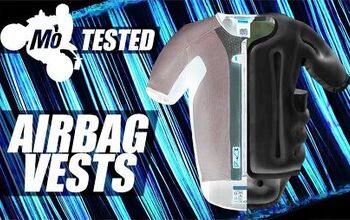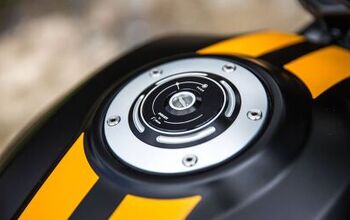Everything You Wanted To Know About MIPS

Diving headfirst into one of the latest trends in helmet innovation
Stop and think about helmets for a minute. Undoubtedly the most important piece of safety equipment motorcyclists wear, have you thought about what goes into testing a helmet? Basically, a helmet is dropped straight down onto a surface and the results of the impact are measured. That’s all well and good, but there’s more to a crash than the impact itself. And besides, how many accidents involve the rider falling straight down, as if dropped from a building?
A motorcycle crash involves the rider moving at some rate of speed, never from a standstill, which means they will hit the ground at an angle. So, apart from the damage that can occur on the skull from impacts, like a fracture, further damage can be done to the brain from the rotation of the head once it hits the ground. Injuries like concussions or hematomas.
The MIPS Difference
This is where MIPS, or the Multi-directional Impact Protection System, comes in. Founded by Peter Halldin, Hans von Holst, and Svein Kleiven in Stockholm, Sweden, the team has spent over two decades studying how the brain responds to crash scenarios and developing a system to help mitigate damage. This research has led to four thesis papers and countless numbers of peer-reviewed studies. In short, the findings reveal the brain is much more sensitive to rotation than it is to lineal force. The practical example is that of a boxer taking multiple straight jabs to the face. Despite the repeat blows, the fighter can still continue and press forward. However, a single hook or an uppercut that lands square on the jaw rotates the boxer’s head, leaving the fighter knocked out in the ring. The body creates its own cerebrospinal fluid, which is our natural protection system that allows the brain to move relative to the skull about 15mm. MIPS essentially mimics this protective fluid.
Contrary to what some might believe, MIPS is not a helmet (although the company’s early days did involve making a helmet – it got shelved early in the prototype phase). It’s a low-friction insert within the helmet – independent from the impact-absorbing EPS liner – allowing the head to rotate 10-15mm relative to the helmet itself. Halldin relates this “slip plane concept” to falling on ice; as the kinetic energy of the impact is redirected, this reduces rotational energy to the brain.
Motorcycle crashes are just one area the MIPS team studies; they’ve looked at crash data across several disciplines – equestrian, skiing, cycling, and American football, just to name a few – to analyze what happens to the brain under all kinds of scenarios. As far as motorcycle crashes are concerned, it found, on average, impacts to the head occur at 12 meters per second (26 mph) at angles less than 30. For its testing protocol, MIPS drops a helmet on the X, Y, and Z planes, onto a surface with a coarse, sandpaper-like finish. It’s dropped with an impact speed of 7.5 meters per second (16.8 mph) at an impact angle of 45º.
If you’ve been paying attention, you’ll notice the impact speed is slower, but the impact angle is greater than the average. What it comes down to is equipment. According to Halldin, MIPS doesn’t have the testing ability for a 12m/s drop, but he is confident the slower speed and greater angle provide an appropriate simulation. The head forms themselves are equipped with a gyroscope inside and are studied using Finite Element Analysis to compare the effects using helmets with and without MIPS. When the results are seen in graph form, the most impressive benefit (in my eyes, anyway) is the drastic reduction in amplitude to the brain as the rotational acceleration and velocity is greatly reduced, ultimately leading to less strain on the brain. Of course, you’d expect the results to favor MIPS, but again, peer-reviewed studies have already validated the tech.
Graphs, charts, and FEA, while useful, never quite compare to real-world examples. Halldin agrees, citing a video of a motocross crash where one rider lost control of his motorcycle, ran off the course, and collided with another competitor at nearly a 90º angle at 50 kph. The rider taking the brunt of the impact suffered, among his injuries, a hematoma in both the front and rear of his brain. The MIPS team were able to recreate the crash via FE modeling using video taken at the scene as well as the rider’s actual helmet showing the impact points. In this recreation, the MIPS-equipped helmet reduced the trauma on the brain to the point the rear brain scan looked perfectly normal.
Developing for Helmet Manufacturers
The thousands of crash tests, models, and independent studies have successfully convinced companies like Alpinestars, Bell, Fox, Troy Lee Designs, and others to develop helmets incorporating MIPS technology, though you’ll notice Bell is the only manufacturer on this list making MIPS-equipped helmets for street motorcycles. Usage application aside, it’s important to know MIPS doesn’t just throw a generic yellow piece of plastic inside a helmet and call it done. They work closely with each manufacturer to design its slip plane to function within the confines of the specific helmet, taking shape, ventilation, cost, and many other factors into consideration.
Detractors
By now you should get the idea here: focusing on more than just the impact in a crash is key, and reducing the amount of head rotation upon the first milliseconds of impact is crucial to the amount of trauma the brain will experience. The science has gained enough traction that other companies are developing their own technologies to deal with rotational energy management, whether that involves the slip plane concept or otherwise.
But is MIPS really all it claims to be? Not if you ask the Snell Foundation. Granted, Snell tested bicycle helmets with and without MIPS technology – and also tested to the Snell protocol, not MIPS – but the test is still relevant. In it, they impacted “the helmet sides to achieve an oblique transmission of energy. The MIPS layer activated and moved. They used both flat and hemispheric impactors, and measured both linear and rotational acceleration. They hit each location twice. Helmet straps were tight. They chose the locations based on a Harborview study of the most likely impact locations on bicycle helmets.”
The conclusion?
Our conclusion is that this testing by a respected lab, reported by an organization with a distinguished history of consumer-oriented helmet activism, shows that MIPS is not likely to help you in a crash configuration similar to the one tested by Snell. Other lab testing using an unrestrained moving headform with a sticky rubber covering and no neck attached impacting a very rough 45 degree slanted anvil with the straps tight over an inflexible jaw (the configuration MIPS uses) has shown that MIPS does reduce rotational acceleration. But when the head is constrained – as by a neck – MIPS does not perform well. That does not happen in the field, where heads are attached to the body. We still think your helmet, with a normal scalp under it, will move anyway.
This Helmets.org story goes into much greater detail about its reservations with MIPS, concluding that a round helmet shape is far more important in avoiding rotational force (the exact philosophy Arai abides by), and that since a helmet isn’t airtight to the user’s head, one’s skin, hair, sweat, and other factors will cause the helmet to slide on a user’s head anyway.
Final Takeaway
No matter which side you stand on, one interesting observation is that nobody is claiming a MIPS-equipped helmet is any worse for your head than a non-MIPS helmet. And in fact, it’s pretty well agreed upon that mitigating the effects of rotational force is important to the rider’s safety. The issue Snell and Helmets.org circle back to is whether MIPS offers any real tangible benefit now that its marketing efforts have soared, especially in the bicycle world.
As far as motorcyclists go, I came away very impressed and convinced by the numerous examples, studies, and demonstrations presented to me after meeting Peter Halldin. It’s hard to argue against independent, peer-reviewed studies, and though the scope of the MIPS research is far too vast to cover here, I advise you visit the MIPS website if you really want to go down the rabbit hole of their testing and practices. Then you can make your own conclusions.

Troy's been riding motorcycles and writing about them since 2006, getting his start at Rider Magazine. From there, he moved to Sport Rider Magazine before finally landing at Motorcycle.com in 2011. A lifelong gearhead who didn't fully immerse himself in motorcycles until his teenage years, Troy's interests have always been in technology, performance, and going fast. Naturally, racing was the perfect avenue to combine all three. Troy has been racing nearly as long as he's been riding and has competed at the AMA national level. He's also won multiple club races throughout the country, culminating in a Utah Sport Bike Association championship in 2011. He has been invited as a guest instructor for the Yamaha Champions Riding School, and when he's not out riding, he's either wrenching on bikes or watching MotoGP.
More by Troy Siahaan







































Comments
Join the conversation
Wow, very interesting topic and a great synopsis of current state of affairs.
Peer-reviewed studies lend significant credibility to the MIPS perspective. But similar results in independent testing is the real acid test. I guess that hasn't happened yet.
A large part of modern life is knowing your acronyms. YKWIM?